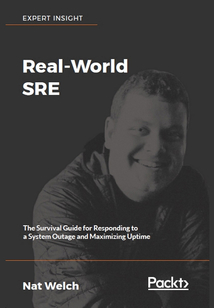舉報 

會員
Real-World SRE
最新章節:
Index
Real-WorldSREisthego-tosurvivalguideforthesoftwaredeveloperinthemiddleofcatastrophicwebsitefailure.SiteReliabilityEngineering(SRE)hasemergedonthefrontlineasbusinessesstrivetomaximizeuptime.Thisbookisastep-by-stepframeworktofollowwhenyourwebsiteisdownandthecountdownisontofixit.NatWelchhasbattle-hardenedexperienceinreliabilityengineeringatsomeofthebiggestoutage-sensitivecompaniesontheinternet.Armyourselfwithhistried-and-testedmethodsformonitoringmodernwebservices,settingupalerts,andevaluatingyourincidentresponse.Real-WorldSREgoesbeyondjustreactingtodisaster—uncoverthetoolsandstrategiesneededtosafelytestandreleasesoftware,planforlong-termgrowth,andforeseefuturebottlenecks.Real-WorldSREgivesyouthecapabilitytosetupyourownrobustplanofactiontoseeyouthroughacompany-widewebsitecrisis.ThefinalchapterofReal-WorldSREisdedicatedtoacingSREinterviews,eitheringettingafirstjoboravaluedpromotion.
目錄(91章)
倒序
- 封面
- Real-World SRE
- Why subscribe?
- PacktPub.com
- Contributors
- Packt is Searching for Authors Like You
- Preface
- Who this book is for
- What this book covers
- To get the most out of this book
- Get in touch
- Chapter 1. Introduction
- A brief history
- What is SRE?
- What is in the book?
- SRE as a framework for new projects
- Summary
- References
- Chapter 2. Monitoring
- Why monitoring?
- Instrumenting an application
- Collecting and saving monitoring data
- Displaying monitoring information
- Managing and maintaining monitoring data
- Communicating about monitoring
- References and related reading
- Summary
- Chapter 3. Incident Response
- What is an incident?
- What is incident response?
- Alerting
- Being on call
- Communication
- Recovering the system
- Calling all clear
- Summary
- Chapter 4. Postmortems
- What is a postmortem?
- Why write a postmortem?
- When to write a postmortem document
- Carrying out incident analysis
- How to write a postmortem document
- Blameless postmortems
- Holding a postmortem meeting
- Analyzing past postmortems
- Summary
- References
- Chapter 5. Testing and Releasing
- Testing
- Releasing
- Automation
- Summary
- Chapter 6. Capacity Planning
- A quick introduction to business finance
- Why plan?
- Defining a plan
- Architecture–where performance changes come from
- Tech as a profit center and procurement
- Summary
- Chapter 7. Building Tools
- Finding projects
- Defining projects
- Planning projects
- Building projects
- Documenting and maintaining projects
- Summary
- Chapter 8. User Experience
- An introduction to design and UX
- User testing
- Developer experience
- Experience of tools
- Performance budgets
- Security
- ACM code of ethics
- Summary
- References
- Chapter 9. Networking Foundations
- The internet
- Sending an HTTP request
- Tools for watching the network
- Summary
- Chapter 10. Linux and Cloud Foundations
- Linux fundamentals
- Cloud fundamentals
- Units of scale
- Example architecture interview
- Summary
- References
- Other Books You May Enjoy
- Leave a review - let other readers know what you think
- Index 更新時間:2021-07-23 19:24:18
推薦閱讀
- 信息安全導論(在線實驗+在線自測)
- 黑客大曝光:無線網絡安全(原書第3版)
- Securing Blockchain Networks like Ethereum and Hyperledger Fabric
- Kali Linux Social Engineering
- 網絡安全保障能力研究
- Rootkit和Bootkit:現代惡意軟件逆向分析和下一代威脅
- INSTANT Windows PowerShell
- Computer Forensics with FTK
- 信息技術基礎:提高篇·實驗與習題
- Mastering Python for Networking and Security
- 物聯網信息安全技術
- 黑客攻擊與防范實戰從入門到精通
- 安全網絡構建
- Blockchain Development with Hyperledger
- AI+網絡安全:智網融合空間體系建設指南
- 網絡安全技術及應用實踐教程
- INSTANT Penetration Testing:Setting Up a Test Lab How-to
- 信息安全風險評估手冊(第2版)
- 從實踐中學習Web防火墻構建
- 云安全實用指南
- 網絡信息安全
- 白話網絡安全
- 信息安全技術專業基于工作過程支撐平臺課程體系開發實踐
- 黑客大曝光:惡意軟件和Rootkit安全(原書第2版)
- 構建可信白環境:方法與實踐
- 黑客攻防實戰從入門到精通(第2版)
- iOS黑客攻防秘籍(第2版)
- 走近安全:網絡世界的攻與防
- 金融網絡安全
- 云計算安全技術

